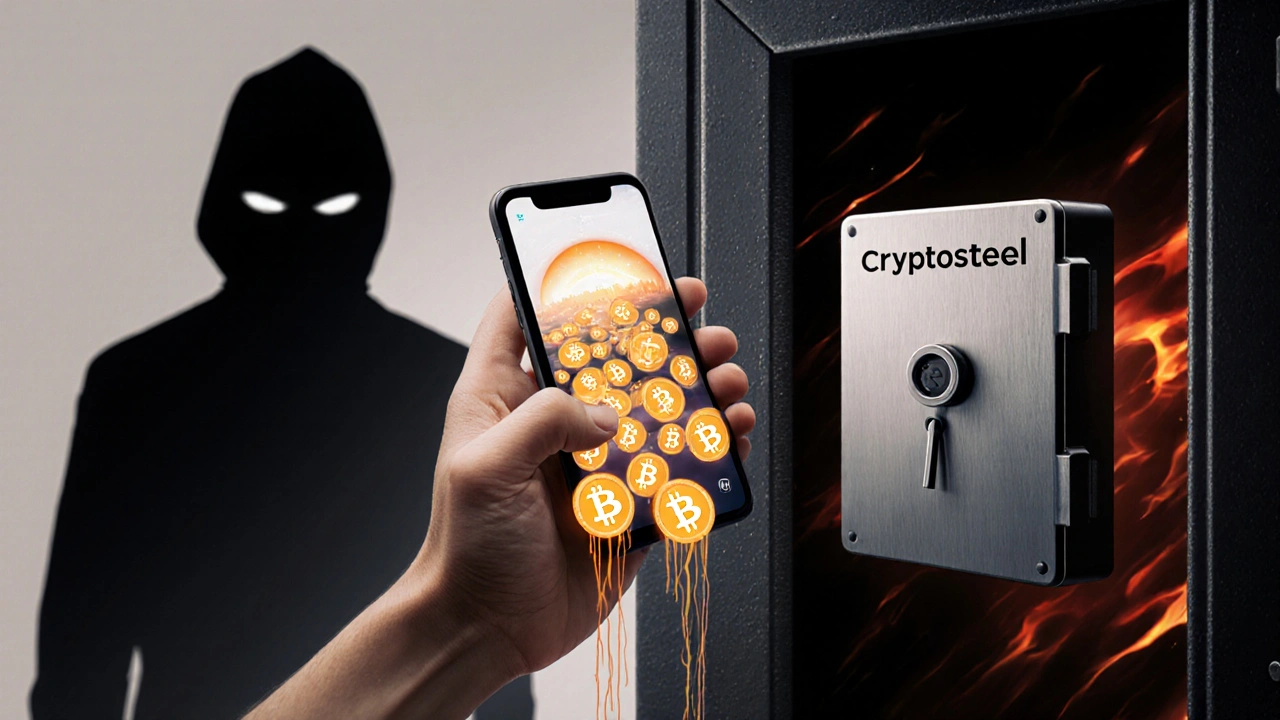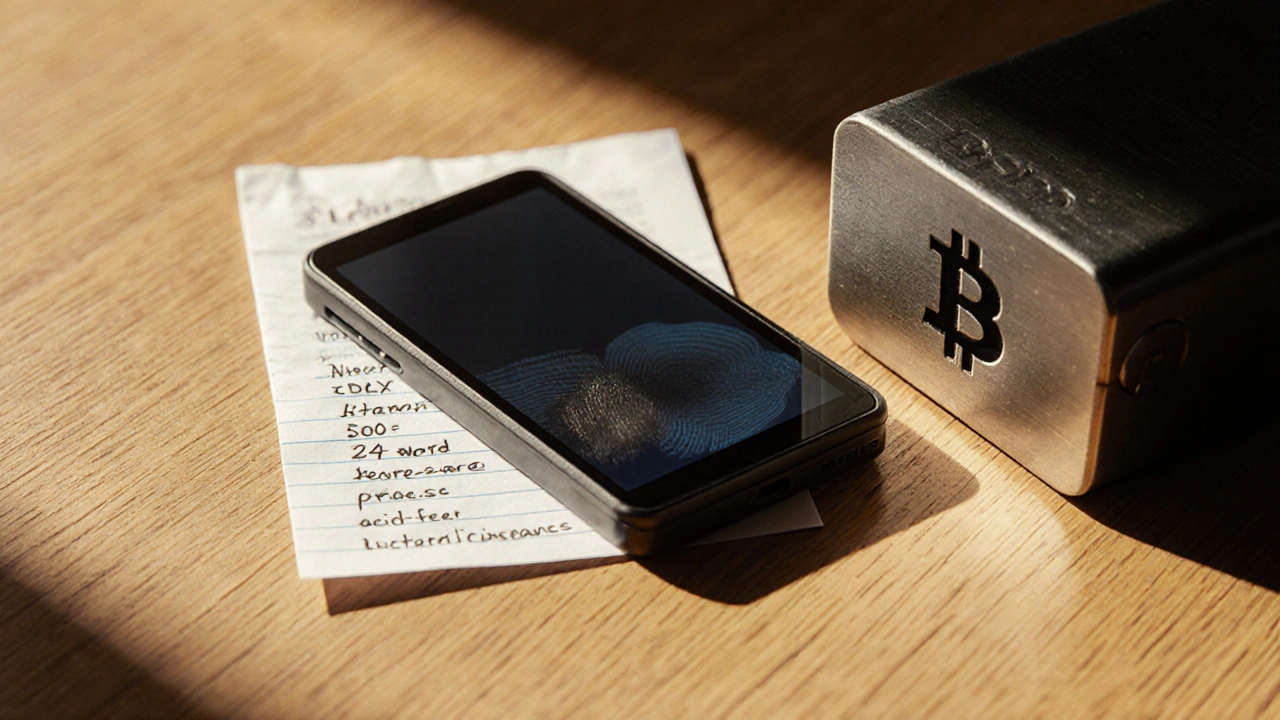If you own Bitcoin, you don’t actually store it in a wallet like you store cash in a pocket. Your Bitcoin exists on the blockchain. What your wallet holds is the private key-the one piece of information that lets you spend your coins. Lose that key, and your Bitcoin is gone forever. No customer service, no password reset, no recovery option. That’s why securing your Bitcoin wallet isn’t just a good idea-it’s the only thing that matters.
Understand the difference between hot and cold wallets
There are two main types of Bitcoin wallets: hot and cold. Hot wallets are connected to the internet. These include apps on your phone, browser extensions, or exchange accounts like Coinbase or Binance. They’re convenient for small amounts you use often, like buying coffee or sending a friend $10. But they’re also easy targets for hackers. Cold wallets are offline. These are hardware devices like Ledger or Trezor, or even paper wallets with your keys printed out. They’re not connected to the internet, so no hacker can reach them remotely. If you’re holding more than a few hundred dollars’ worth of Bitcoin, you should keep it in a cold wallet. Most people make the mistake of keeping all their Bitcoin in a hot wallet because it’s easy. Don’t. Use hot wallets only for daily spending. Keep the rest cold.Use a hardware wallet for long-term storage
Hardware wallets are the gold standard for Bitcoin security. Devices like Ledger Nano X, Trezor Model T, or BitBox02 are designed to store private keys offline. Even if your computer gets infected with malware, your keys stay safe inside the device. When you set up a hardware wallet, you’ll be given a 12- or 24-word recovery phrase. This is your backup. Write it down on paper. Don’t type it into a computer. Don’t take a photo of it. Don’t store it in a cloud note app. Keep it in a fireproof safe or a secure metal vault. If you lose the device, you can plug in a new one and restore everything using this phrase. Never share your recovery phrase with anyone-not even someone claiming to be from support. No legitimate company will ever ask for it. If you do, your Bitcoin is gone.Enable two-factor authentication (2FA) everywhere
If you use a hot wallet or an exchange, turn on two-factor authentication. But don’t use SMS-based 2FA. Text messages can be hijacked through SIM swapping attacks. Instead, use an authenticator app like Authy, Google Authenticator, or Raivo. These apps generate time-based codes on your phone. Even if someone steals your password, they still need the code from your phone to log in. Keep your phone locked with a strong PIN or biometric lock. And never install unknown apps on the same device where your 2FA app lives. Some advanced users prefer hardware security keys like YubiKey. These plug into your computer or connect via NFC and provide the strongest form of 2FA. They’re overkill for casual users, but if you’re holding tens of thousands in Bitcoin, they’re worth it.Never reuse passwords or use weak ones
If you use the same password for your email, your exchange account, and your wallet app, you’re asking for trouble. One data breach, and your entire crypto life is exposed. Use a password manager like Bitwarden or 1Password to generate and store unique, random passwords for every account. These tools create passwords likexK9#mQ2$vL8!pWnR-something no human could guess or remember. You only need to remember one master password.
And never, ever write your passwords on sticky notes. I’ve seen people leave them taped under their keyboards. That’s not security. That’s a gift to anyone who walks into your room.

Backup your recovery phrase properly
Your recovery phrase is the only thing that can restore your Bitcoin if you lose your device. Treat it like a birth certificate or a will. One copy is not enough. Two copies are better. Three copies, stored in different places, are ideal. Use a metal backup device like Cryptosteel or Billfodl. These are engraved steel plates that survive fire, water, and crushing. Store one at home, one in a safety deposit box, and one with a trusted family member who knows what it is and how to use it. Never store your recovery phrase digitally. Not in Notes. Not in iCloud. Not on Google Drive. Not even encrypted. If your phone gets stolen or your cloud account is hacked, that phrase can be found and used to drain your wallet. Test your backup. Once a year, take your recovery phrase and restore it on a brand-new hardware wallet. Make sure it works. If it doesn’t, you’ve got a problem before it’s too late.Watch out for phishing and scams
The biggest threat to your Bitcoin isn’t hackers-it’s you. Scammers know this. They send fake emails that look like they’re from Coinbase. They create fake websites that mimic Ledger’s login page. They post YouTube videos showing "how to recover lost Bitcoin"-and then ask for your recovery phrase to "help you." Always type the website address yourself. Never click links in emails or DMs. Bookmark your exchange and wallet sites. Check the URL carefully. A fake Ledger site might beledger.co-close, but not the same as ledger.com.
Never download wallet apps from third-party app stores. Only install apps from the official Apple App Store or Google Play Store. Even then, check the developer name. The real Trezor app is made by Trezor Technologies s.r.o., not Trezor Wallet or some random company.
Don’t store Bitcoin on exchanges
Exchanges are the most common target for hackers. In 2024, the crypto industry lost over $1.2 billion to exchange hacks and insider theft. Even the biggest names like Binance and Kraken have been breached. When you keep Bitcoin on an exchange, you don’t own the keys. The exchange does. You’re trusting them to keep your coins safe. That’s like leaving your house key with a stranger who lives next door. If you’re holding Bitcoin for more than a week, move it to your own wallet. Exchanges are for trading, not storage. Once you buy, withdraw immediately.
Regularly update your software
Hardware wallets and wallet apps get updates. These aren’t just for new features-they fix security holes. A 2023 study by Chainalysis found that 40% of stolen Bitcoin came from wallets using outdated software. Enable automatic updates on your hardware wallet and phone apps. If you’re using a desktop wallet like Electrum, check for updates monthly. Don’t ignore notifications. A single unpatched vulnerability can cost you everything.Use multisig for high-value holdings
If you’re holding more than $10,000 in Bitcoin, consider a multisig wallet. This requires two or more private keys to sign a transaction. For example, you could set up a 2-of-3 multisig: one key on your hardware wallet, one on your spouse’s phone, and one stored in a safe. Even if one key is stolen, the attacker can’t move the funds. Services like Sparrow Wallet or Unchained Capital make multisig easy to set up without needing to be a coder. It adds a layer of complexity, but for serious holders, it’s the closest thing to bulletproof security.What to do if your wallet is compromised
If you think your wallet has been hacked-maybe you clicked a bad link, or your phone was stolen-act fast. 1. Stop using the device immediately. Unplug it. Power it off. 2. If you have funds in another wallet, move them now. 3. Don’t panic. Don’t call anyone claiming to be a "crypto recovery specialist." They’re scammers. 4. If you have a backup, restore to a new, clean device. 5. Report the incident to your local authorities. While they can’t recover your Bitcoin, they can help track patterns and prevent others from being scammed. Most importantly: learn from it. Figure out how it happened. Then fix it before you make the same mistake again.Can I recover my Bitcoin if I lose my private key?
No. Bitcoin is designed to be irreversible. If you lose your private key or recovery phrase, there is no way to get your Bitcoin back. There are no companies, governments, or hackers who can recover it for you. That’s why backing up your recovery phrase correctly is the most important step you’ll ever take.
Is a paper wallet still safe to use?
Paper wallets were popular in the early 2010s, but they’re not recommended today. They’re hard to generate securely, prone to human error, and vulnerable to physical damage like fire, water, or fading ink. Metal backups are far more reliable and durable. If you still have a paper wallet, move the funds to a hardware wallet and destroy the paper.
Should I use a mobile wallet for Bitcoin?
Mobile wallets are okay for small amounts you use daily, like $50-$200. But they’re not safe for large holdings. Phones are constantly connected to the internet, get hacked, get lost, and can be infected with malware. For anything more than daily spending, use a hardware wallet.
How much Bitcoin should I keep in a hot wallet?
Keep only what you plan to spend in the next 30 days. That’s usually $100-$500 depending on your usage. Anything beyond that should be moved to a cold wallet. The rule is simple: the less you keep online, the safer you are.
Are hardware wallets really hack-proof?
No device is 100% hack-proof, but hardware wallets are the safest option available to regular users. They’re designed to keep keys offline and require physical access to sign transactions. Even if your computer is infected, the wallet won’t send coins unless you physically press a button on the device. That physical step is what makes them so secure.
If you follow these steps, your Bitcoin will be among the most secure in the world. It’s not about being a tech expert. It’s about being careful. One mistake can cost you everything. But if you take the time to do it right, you’ll sleep better knowing your Bitcoin is safe-for good.

